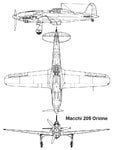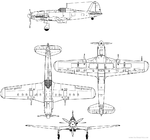oldcrowcv63
Tech Sergeant
I never really looked at the two aircraft side by side and in profile, but it seems they are so similar that I can't help but wonder if there wasn't some kind of common design template for this generation of Italian fighter aircraft. Are they really the result of entirely independent design teams or just an artifact of design driven by sharing essential the same engine?
They might also be compared to the somewhat more distinctly different Reggiane Re.2005
Top: Macchi: 1st flt.: April 19, '42, 262 built in WW2
middle: Fiat: 1st flt.: April 30, '42, 274 built in WW2
bottom: Reggiane 1st flt.: May 9, '42, 48 built in WW2
In general they are pretty good looking a/c.
They might also be compared to the somewhat more distinctly different Reggiane Re.2005
Top: Macchi: 1st flt.: April 19, '42, 262 built in WW2
middle: Fiat: 1st flt.: April 30, '42, 274 built in WW2
bottom: Reggiane 1st flt.: May 9, '42, 48 built in WW2
In general they are pretty good looking a/c.
Attachments
Last edited:







